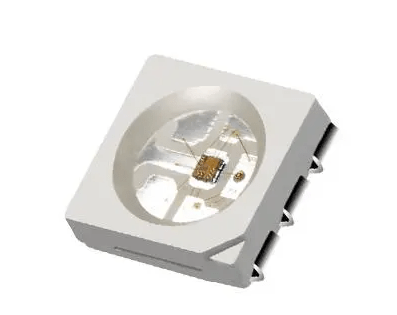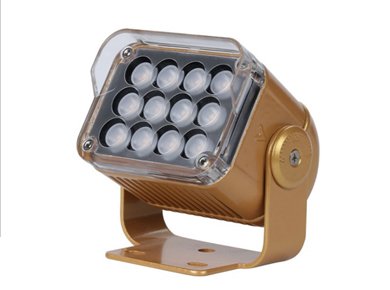Perovskite Light-Emitting Diodes (LEDs) represent an emerging display technology. How can the efficiency bottleneck in perovskite LED red-light emission be overcome? The latest research by Shanghai University, published in the "Nature" journal, has set a new record for the luminous efficiency of red-light perovskite LEDs.
On June 13, reporters from The Paper (thepaper.cn) learned from Shanghai University that on June 12, 2024, the research team led by Professor Yang Xuyong from the School of Mechanical Engineering and Automation's Xinxiang Key Laboratory of Education at Shanghai University, in collaboration with partner teams, published their latest research findings titled "Fabrication of red-emitting perovskite LEDs by stabilizing their octahedral structure" in the prestigious international journal "Nature." This marks the first paper from the School of Mechanical Engineering and Automation at Shanghai University to be published in "Nature" with the first author, the principal completing unit, and the corresponding author all from the institution.

Screenshots of papers
Traditional monodentate coordinating molecules, while adjusting the emission spectrum of iodine-based perovskites, inevitably significantly reduce their photoluminescence quantum yield. How to achieve high-efficiency red-light emission without sacrificing the optoelectronic properties of perovskites has been a significant challenge limiting the performance of red-light perovskite LEDs. Innovatively, the research team used a unique bidentate organic molecular coordination to "anchor" the perovskite surface and stabilize its octahedral structure. This approach successfully overcame the mutual constraints between spectral tuning and optoelectronic properties of perovskite films, thus breaking through the efficiency bottleneck of red-light emission in perovskite LEDs. The resulting LED devices exhibit continuous and adjustable spectra in the pure red light range of 620nm-650nm, with an external quantum efficiency (EQE) of 28.7% for LEDs emitting at 638nm, setting a new record for the luminous efficiency of red-light perovskite LEDs. Moreover, the devices show exceptionally excellent spectral stability, with almost no separation in the radiative recombination centers under a bias of up to 8V. This research will accelerate the industrialization process of perovskite LEDs for display.
Research team photo - This article's images source from "Shanghai University" official account.
This research was jointly completed by Shanghai University, Jilin University, and the Cavendish Laboratory at the University of Cambridge, with Shanghai University as the first signing unit. Professor Yang Xuyong from Shanghai University served as the corresponding author of the paper, with Professor Wang Ning from Jilin University and Professor Neil C. Greenham from the University of Cambridge as co-corresponding authors. Kong Lingmei, a Ph.D. student of Shanghai University's class of 2021 under the guidance of Professor Yang Xuyong, was the first author of the article. Co-signed authors of the paper include Feng Jie, Wang Yuanzhi, and Liu Zirui from Shanghai University's School of Mechanical and Electrical Engineering; Zhao Bin and Dong Jianchao from the School of Physics at Jilin University; Professor Samuel D. Stranks, Professor Richard H. Friend, Dr. Sun Yuqi, Dr. Ji Kangyu, Dr. Dai Linjie, and Dr. Shabnum Maqbool from the Cavendish Laboratory at the University of Cambridge; Professor Li Yunguo from the University of Science and Technology of China; Professor Yang Yingguo from Fudan University; and Professors Wanhee Lee and Changsoon Cho from Pohang University of Science and Technology.
This research was jointly completed by Shanghai University, Jilin University, and the Cavendish Laboratory at the University of Cambridge, with Shanghai University as the first signing unit. Professor Yang Xuyong from Shanghai University served as the corresponding author of the paper, with Professor Wang Ning from Jilin University and Professor Neil C. Greenham from the University of Cambridge as co-corresponding authors. Kong Lingmei, a Ph.D. student of Shanghai University's class of 2021 under the guidance of Professor Yang Xuyong, was the first author of the article. Co-signed authors of the paper include Feng Jie, Wang Yuanzhi, and Liu Zirui from Shanghai University's School of Mechanical and Electrical Engineering; Zhao Bin and Dong Jianchao from the School of Physics at Jilin University; Professor Samuel D. Stranks, Professor Richard H. Friend, Dr. Sun Yuqi, Dr. Ji Kangyu, Dr. Dai Linjie, and Dr. Shabnum Maqbool from the Cavendish Laboratory at the University of Cambridge; Professor Li Yunguo from the University of Science and Technology of China; Professor Yang Yingguo from Fudan University; and Professors Wanhee Lee and Changsoon Cho from Pohang University of Science and Technology.


 6W LED module spot light beam ...
6W LED module spot light beam ... 思域EN-402W 说明书 V1.0 (适用A1)
思域EN-402W 说明书 V1.0 (适用A1) 思域EN-508W 说明书 V1.0 (适用于A1)——PC ...
思域EN-508W 说明书 V1.0 (适用于A1)——PC ... 思域SN-500 说明书 V2.2 (适用B2, C2, C ...
思域SN-500 说明书 V2.2 (适用B2, C2, C ...